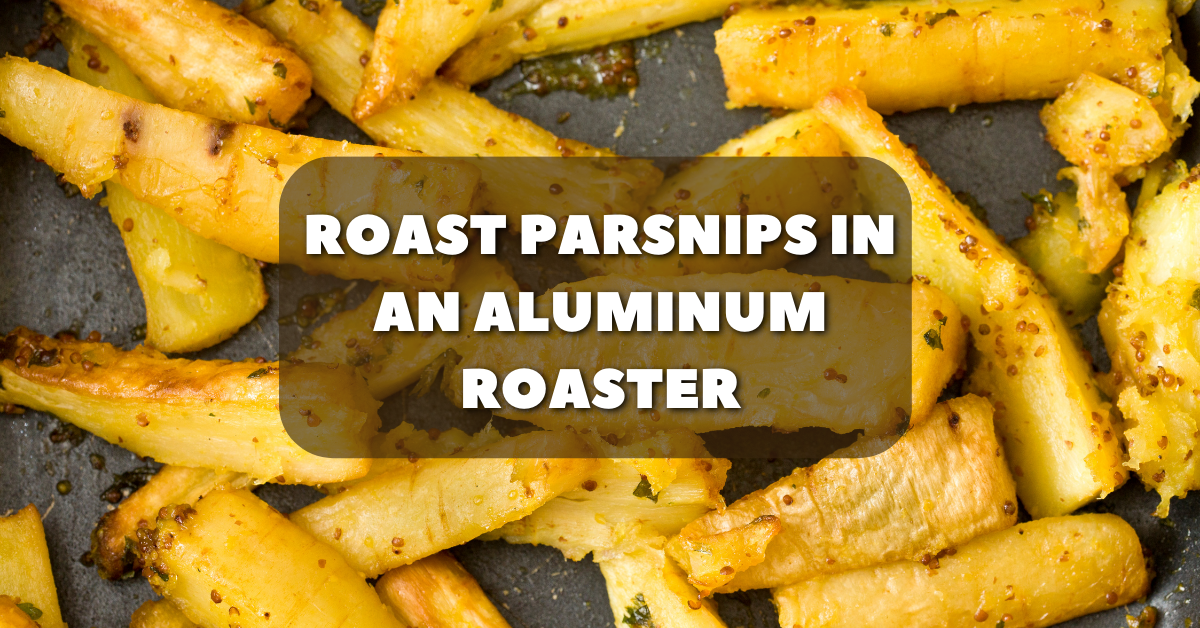Hey there! I’ve got a tasty treat for you today: roasted parsnips!
These little root vegetables might not get as much attention as their carrot cousins, but they’re super tasty and packed with nutrients.
Plus, they’re super easy to roast in an aluminum roaster, which is why I’m here to help you out.
Now, you might be wondering what exactly an aluminum roaster is and why you should use one to roast parsnips (or any other vegetables, for that matter).
Well, an aluminum roaster is a type of cooking pan that’s made of, you guessed it, aluminum.
It’s typically rectangular in shape and has raised sides to help contain and circulate heat while you’re cooking.
And while there are plenty of other materials that roasters can be made of (like stainless steel, ceramic, or cast iron), aluminum is a great choice because it’s lightweight, durable, and heats up evenly.
So if you’re looking for a quick and easy way to roast some tasty parsnips, an aluminum roaster is definitely the way to go.
In this article, I’ll show you how to choose the right aluminum roaster, prep your parsnips, and roast them to perfection.
And by the end, you’ll be a pro at roasting parsnips (and maybe even a few other vegetables) in an aluminum roaster!
Choosing an Aluminum Roaster
Before you can start roasting your parsnips, you’ll need to choose the right aluminum roaster.
There are a few different factors to consider when selecting an aluminum roaster, so let’s take a look at each one:
- Size and shape: The first thing you’ll want to consider is the size and shape of the aluminum roaster. If you’re only roasting a few parsnips, a small or medium-sized roaster will probably do the trick. But if you’re feeding a crowd or want leftovers, you’ll want to opt for a larger roaster. In terms of shape, rectangular roasters are the most common, but you can also find roasters in other shapes like round or oval. Just make sure to choose a roaster that’s big enough to hold all your parsnips without overcrowding them.
- Features: Another thing to consider is the features of the aluminum roaster. Some roasters come with additional features like a nonstick surface, a built-in thermometer, or a self-basting lid. While these features can be convenient, they can also add to the cost of the roaster. So think about which features are most important to you and your cooking needs, and choose a roaster that fits your budget.
- Price: Speaking of budget, the price of the aluminum roaster is another important factor to consider. You can find roasters at a wide range of price points, from less than $10 to over $100. Again, think about which features are most important to you and how often you plan to use the roaster. If you’re only planning on using it once in a while, you might be able to get away with a cheaper roaster. But if you’re a frequent roaster, it might be worth it to invest in a higher-quality roaster that will last longer.
I hope this section on choosing an aluminum roaster was helpful!
In the next section, we’ll cover how to prepare your parsnips for roasting. So stay tuned 🙂
Preparing the Parsnips
Before you can start roasting your parsnips, you’ll need to prepare them by following these steps:
- Wash and peel the parsnips: Start by washing the parsnips under cool running water to remove any dirt or debris. Then, using a vegetable peeler or a paring knife, remove the skin from the parsnips. If the parsnips are particularly dirty or have a tough outer layer, you might need to scrub them gently with a vegetable brush before peeling.
- Cut the parsnips into evenly-sized pieces: Once the parsnips are peeled, it’s time to cut them into evenly-sized pieces. This will help ensure that they roast evenly and don’t overcook or undercook. To do this, slice the parsnips in half lengthwise, then cut them into slices or wedges depending on your desired size. Aim for pieces that are about 1/2 to 3/4 inches thick.
- Toss the parsnips with oil and seasonings: Once the parsnips are cut, toss them in a bowl with a drizzle of oil (olive, avocado, or coconut oil all work well) and any seasonings you like. Some options might include salt, pepper, garlic powder, onion powder, paprika, or thyme. Use your hands to evenly coat the parsnips with the oil and seasonings.
And that’s it! Once your parsnips are prepared, you’re ready to roast them in the aluminum roaster.
In the next section, we’ll cover how to do that.
Also See: How to Season an Aluminum Roaster: (Explained!)
Roasting the Parsnips
Now that your parsnips are prepared and seasoned, it’s time to roast them in the aluminum roaster.
Here’s how to do it:
- Preheat the oven and the aluminum roaster: Preheat the oven to 400 degrees Fahrenheit and place the aluminum roaster on the middle rack. If your aluminum roaster has a nonstick surface, you don’t need to oil it. But if it doesn’t, you’ll want to lightly coat it with cooking spray or a small amount of oil to prevent the parsnips from sticking.
- Add the parsnips to the aluminum roaster: Once the oven and the aluminum roaster are preheated, add the seasoned parsnips to the roaster in a single layer. Make sure to leave some space between the parsnips to allow for proper circulation of heat.
- Roast the parsnips: Place the aluminum roaster in the preheated oven and roast the parsnips for 20-25 minutes, or until they’re tender and caramelized. You can flip the parsnips halfway through cooking to ensure even roasting, but this isn’t strictly necessary.
- Serve the roasted parsnips: Once the parsnips are cooked, remove the aluminum roaster from the oven and transfer the parsnips to a serving dish. If you like, you can garnish them with additional seasonings or herbs before serving.
And that’s all there is to it!
Roasting parsnips in an aluminum roaster is super easy and produce delicious, perfectly cooked parsnips every time.
In the next section, we’ll cover how to serve and store your roasted parsnips. Stay tuned!
Serving and Storing the Roasted Parsnips
Now that your parsnips are perfectly roasted, it’s time to serve them up!
Here are a few ideas for serving your roasted parsnips:
- As a side dish: Roasted parsnips make a great side dish for all sorts of meats, from roast chicken or turkey to grilled steak or pork chops. You can serve them on their own or toss them with a few other roasted vegetables for a colorful and flavorful side.
- In a salad: Roasted parsnips are also great in salads, either on their own or mixed with other roasted vegetables. You can toss them with a simple vinaigrette or a creamy dressing, and add in some greens, nuts, or cheese for extra flavor and texture.
- As a snack: If you have leftovers, you can chop up the roasted parsnips and enjoy them as a snack. They’re delicious on their own or mixed with other roasted vegetables and served with hummus or another dip.
Once you’ve served your roasted parsnips, you might have leftovers.
Here’s how you can store them:
- In the fridge: If you have leftover roasted parsnips, you can store them in an airtight container in the fridge for up to 3-4 days.
- In the freezer: If you want to keep your roasted parsnips for longer, you can freeze them. To do this, let the parsnips cool completely, then wrap them tightly in plastic wrap or aluminum foil. Place the wrapped parsnips in a zip-top bag and freeze them for up to 3 months. To reheat frozen parsnips, thaw them in the fridge overnight, then place them in an aluminum roaster and roast at 350 degrees Fahrenheit for 10-15 minutes, or until heated through.
Conclusion
In this article, we covered how to roast parsnips in an aluminum roaster.
We discussed the benefits of using an aluminum roaster and how to choose the right one for your needs.
We also covered the steps for preparing parsnips and roasting them to perfection.
And finally, we provided some ideas for serving and storing the roasted parsnips.
I hope you found this article helpful and that it inspires you to give roasting parsnips in an aluminum roaster a try!
Roasting vegetables in an aluminum roaster is a quick and easy way to bring out their natural flavors and nutrients, and parsnips are no exception.
So give them a try and see for yourself how delicious roasted parsnips can be.
And if you do try roasting parsnips in an aluminum roaster, I’d love to hear how it went!
Share your results and any tips or tricks you have in the comments below.
Thanks for reading, and happy roasting!
Oh, by the way, you may like this article about the Best Benefits of Using an Aluminum Roaster.
Check it out to learn more.

